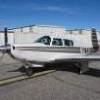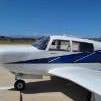-
Posts
838 -
Joined
-
Last visited
-
Days Won
4
wombat last won the day on November 18 2024
wombat had the most liked content!
Profile Information
-
Gender
Not Telling
-
Location
Carlton, WA
-
Interests
Experimental aircraft: Currently building a Velocity
-
Reg #
N5773S
-
Model
M20k Rocket
-
Base
2S0
Recent Profile Visitors
4,524 profile views
wombat's Achievements
-
The autopilot wasn't working, but it sounds like the attitude indicator functionality was still working OK?
-
Real world Rocket owner here. A consistent 1,000 NM range is unrealistic for any Mooney. At least in my Rocket (which is a little on the slower end) I wouldn't count on 1,000 NM in any direction but East, and even then I ned a pretty good tailwind and willingness to climb high. Re: FIKI... FIKI is nice, but a non-FIKI TKS is functionally similar. The FIKI changes are redundancy and a heated stall vane. The TKS panels are technically different, but functionally the same. As long as everything works and nothing breaks the only difference is the stall warning horn. So be careful when/where you fly. Look at the SKEW-T LOG-P diagrams to find an altitude that is likely to not have ice. Don't plan to land at a short runway unless you know the stall warning will free after any ice encounters. Always have an out or two. But an AIRMET is not "Known Icing Conditions", neither is a PIREP from any time before now. But with that being said: don't be stupid. Or as they say: "Fly good. Don't suck." And @1980Mooney referenced this knowledge but to make it very clear: CAV Ice doesn't make a FIKI install for a 14V system for Mooneys so if you have a 14V plane it's not possible to get a FIKI system on it without paying for the certification which is probably in the $10,000,000 range to accomplish. https://www.noaa.gov/jetstream/upperair/skew-t-log-p-diagrams
-
How many bolts hold the prop on the flange, and are they always re-clocked to the same position when re-installing? I thought there were 6 bolts, so if they remove and re-install in a different orientation, you could be off by 1/6, 1/3, 1/2, 2/3, or 5/6 of a rotation, or be exactly where you were before.
-
Did the AI still track the horizon? Did the message just pop up unexpectedly? I'd be a little concerned if that happened while on an approach, but they did provide a nice big 'back' button that would probably bring the screen back to normal.
-
Ahh, but I don't want a ferry pilot; I want to fly my plane. Unfortunately I am not current on medical and IFR. I considered trying to find a CFII (or good weather and any rated PPL or better to be a safety pilot) and an AME so I could renew my medical and get my IFR currency back but I decided that I'd prefer to do it this way. This leaves me in Portland in late December which actually work fairly well for me. Part of my reasoning is that I want to inspect the new paint and interior on the plane.
-
Note: I've found someone based at the SMX airport that should work out great for me. My Mooney Rocket is finishing up in a paint shop down in Santa Maria, CA and I need to get it back to Portland Troutdale for the annual. I need an IFR current CFI with Mooney experience for 2 full days during the week of 15 December. Adventure! Excitement! But not too much. My plan is: You are based either within driving distance of Portland, OR or Santa Barbara (Or Santa Maria), CA. I pay for your airline ticket either to Santa Barbara, CA or back to Portland, OR and a hotel for you, and two days of your time or more if we are waiting on WX. You sit right seat and provide instruction on the XC flight from KSMX to KTTD. I'm planning for about 3 hours of flight time. We should expect to use O2 and to be IFR Why do I need a CFI? I'm one approach short of being IFR current. I'm 5 days beyond my current medical. I'm out of the country so I can't fix either of those issues easily. Ideally this flight will happen during a relatively short window although there's not an absolute 'must-go' date. But I don't want to wait in a hotel room for a week for the weather to clear enough to conduct the flight under VFR About me: 2,200+ hours Instrument Commercial CFI 600+ hours in M20 (300+ in this aircraft) About the aircraft: M20K 305 Rocket In annual until 1 Feb 2026 G500 GTN750xi KFC150 Autopilot Non-FIKI TKS
-

Cigarette Lighter socket as USB power source
wombat replied to PeterRus's topic in General Mooney Talk
From Starlink's website: To power your Starlink Mini, you will need a USB PD source with a minimum rating of 100W, 20V/5A. Please note that Starlink Mini will not work with USB PD ratings of 65W or lower. https://starlink.com/support/article/fba85643-e7fa-4b55-21e5-021422d5701e?srsltid=AfmBOoqy1zNMiIgQH-JuuZfHrM1zeDgFw2DCi0j1VtfS-Q53PX52F1y6 I'm amused/puzzled by this: Some of us are uncomfortable using the certified, guaranteed protected onboard power system to power a Commercial Off-The-Shelf (COTS) Starlink device. As a risk mitigation measure, we are choosing to bring in a battery pack that has a demonstrated history of destroying Mooneys while in operation. On the other hand, I think the actual risk level here is extremely low; we're all probably more likely to be hit and killed by a blue vehicle on the way to or from the airport than we are to be injured or killed by an electrical issue from having a Starlink plugged into aircraft power or a battery system. Much better risk mitigation would be to mitigate fuel level inaccuracies, emergency procedures for open doors (including oil doors), and VFR-into-IMC even for those who are instrument rated and current. -
This is not in a Mooney but I found one report of an iPad catching fire on an airplane: https://www.youtube.com/watch?v=x06_h_fa1gw iPads not perfectly safe but the risk of a fire is quite low frequency. How much time/effort/money/space/weight is the right amount to mitigate this risk? IMO, next to none. While the risk is there, after 15 (almost 16) years since the iPad was released there have been several iPad fires, but we are probably all better off directing our resources to mitigate other risks before we spend any mitigating this one.
-
I got the R5 (with lazy susan) for my Rocket. It is nice that I can also use it for other aircraft. Example:
-
While I agree that this is a really cool little pump, when is the last time anyone here has had a low tire away from their home base airport that wasn't a complete flat that needed a tire or tube replaced? I've only been flying for about 16 years but I've never had it happen or seen it happen. For me, I've had one flat tire away from home base (when I was trying to pick up a new-to-me airplane) but the tube was shot so no amount of air would have helped. I've seen flat tires happen to two people away from their home base, but in both cases a tire inflator wouldn't have helped, they needed tools and parts as well (jacks, wrenches, tubes, tires) If you tie down or hangar somewhere without power this might be useful, but I wouldn't take it with me on a flight.
-
The shop didn't have to run any wires for my upgrade. If you have a G500 series and legacy compatible autopilot (KFC, KAP, etc) this is a great deal.
-
My plane is in the paint shop (ArtCraft paint) in Santa Maria California right now. Dropped it off on September 12th. They are doing both paint and interior. I'll make a thread with progress and pictures. But for now:






